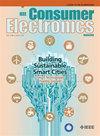基于SOSMCC干扰观测器的太阳能光伏增强电动汽车电池充电方案,通过SABCAF控制实现电网无缝集成
IF 4.3
2区 计算机科学
Q1 ENGINEERING, ELECTRICAL & ELECTRONIC
引用次数: 0
摘要
通过太阳能光伏充电,实现汽车行业零碳排放的愿景,促进清洁能源运输并支持可持续发展。因此,本文提出了将电动汽车(EV)电池储能(BES)系统和线性/非线性负载相结合的可持续解决方案,将太阳能光伏(SPV)系统集成到住宅电网中。它利用二阶滑模级联控制(SOSMCC)来调节直流链路电压并管理电动汽车电池的充电/放电操作。该控制系统增强了扰动观测器,可以处理一个周期内各种动态情况下直流电压的超调/欠调,如负载摄动、太阳日照变化、电网和车辆充电模式之间的转换。在比较多个扰动观测器的性能后,线性扩展状态扰动观测器(LESDO)在其他观测器中表现出最低的欠冲值(小于5%)和最低的沉降时间。采用鲁棒的稀疏感知偏压补偿自适应滤波(SABCAF)算法计算负载电流的基频分量,有效地降低了变形负载电流的高次谐波分量。对比分析表明,SABCAF控制通过减小均方误差(MSE)、提高收敛速度、向电网注入低谐波电流来改善系统动力学,从而改善配电网的电能质量。总谐波失真(THD)分析符合IEEE 519标准,小于5%。本文章由计算机程序翻译,如有差异,请以英文原文为准。
Solar PV-Based Enhanced EV Battery Charging Solution With SOSMCC Disturbance Observer for Seamless Grid Integration via SABCAF Control
The vision of achieving zero-carbon emissions in the automobile sector, powered by solar PV-based charging, fosters clean energy transportation and supports sustainable development. Therefore, this paper proposes a sustainable solution for integrating solar photovoltaic (SPV) systems into residential grids by incorporating an electric vehicle (EV) battery energy storage (BES) system and linear/nonlinear load. It utilizes a second-order sliding mode cascaded control (SOSMCC) to regulate the DC-link voltage and manage EV battery charge/discharge operations. This control system is enhanced with disturbance observers to handle the overshoot/undershoot in the DC-link voltage within a cycle under various dynamic situations, i.e., load perturbation, changing solar insolation, and transitions between grid and vehicle charging modes. After comparing the performance of multiple disturbance observers, the linear extended state disturbance observer (LESDO) demonstrates the lowest undershoot (less than 5%) and settling time among other observers. A robust Sparse-Aware Bias-Compensated Adaptive Filtering (SABCAF) algorithm is employed to calculate the fundamental component of load current, effectively reducing higher and suborder harmonic components from deformed load currents. The comparative analysis shows that SABCAF control improves system dynamics by minimizing mean square (MSE) error, enhancing convergence speed, and injecting lower harmonic currents into the grid, thus improving the power quality of the distribution network. The total harmonic distortion (THD) analysis complies with IEEE 519 standard which is less than 5%.
求助全文
通过发布文献求助,成功后即可免费获取论文全文。
去求助
来源期刊
CiteScore
7.70
自引率
9.30%
发文量
59
审稿时长
3.3 months
期刊介绍:
The main focus for the IEEE Transactions on Consumer Electronics is the engineering and research aspects of the theory, design, construction, manufacture or end use of mass market electronics, systems, software and services for consumers.

 求助内容:
求助内容: 应助结果提醒方式:
应助结果提醒方式:


